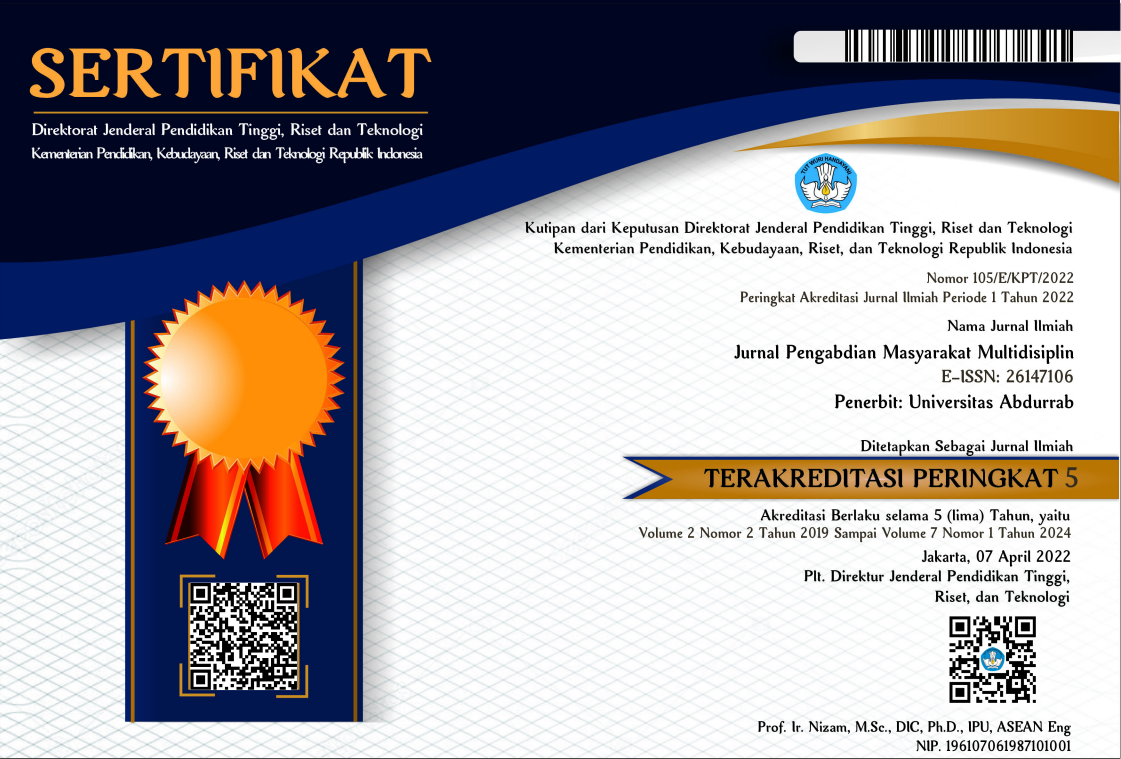PEER COUNSELING ANTI BULLYING UNTUK MENINGKATKAN KESEHATAN MENTAL
Abstract
In recent years, bullying cases have been quite concerning. Bullying or bullying is very threatening to the mental state of children. Bullying is a repetitive negative behavior that is carried out consciously, usually carried out by a person or group of people who have more power than the victim. For this reason, it is important for educational institutions to prepare or design Peer Counseling training for their students to support students' mental quality and minimize bullying problems that arise among school youth. This program was carried out using the TOT (training of trainer) method with a total of 15 peer counselors. The scales used are the empathic listening and Mental Health scales. The implications of this program can be used as a reference and understanding for female students in efforts to prevent and minimize cases of bullying that occur among school students. By conducting peer counseling training and mental health seminars with the theme of bullying at school, students can actively practice what they have learned from the service program in the hope of being able to help the performance of guidance and counseling teachers at school.
References
R. Ramadhanti and M. T. Hidayat, “Strategi Guru dalam Mengatasi Perilaku Bullying Siswa di Sekolah Dasar,” J. Basicedu, vol. 6, no. 3, pp. 4566–4573, 2022, doi: 10.31004/basicedu.v6i3.2892.
R. Alfarina and N. Widiasmara, “Tinjauan Naratif Konseling Islam Dalam Menangani Kasus Bullying yang Berdampak terhadap Kesehatan Mental pada Siswa di Sekolah,” Bandung Conf. Ser. …, pp. 780–789, 2022, [Online]. Available:
https://proceedings.unisba.ac.id/index.php/BCSPS/article/view/4876
V. D. Wicaksono, Anti-bullying Programs in Indonesia: An Integrative Review of Elementary Schools. Atlantis Press SARL, 2023. doi: 10.2991/978-2-38476-008-4_77.
D. P. F. Hannah Gaffney, Maria M. Ttofi, “What works in anti-bullying programs? Analysis of effective intervention components,” J. Sch. Psychol., vol. 85, pp. 37–56, 2021, [Online]. Available: https://doi.org/10.1016/j.jsp.2020.12.002
S. Tohari, M. E. Prasetia, S. A. Hayati, U. Islam, K. Muhammad, and A. Al, “Implementasi Strategi Guru Bimbingan Dan Konseling Dalam Mengatasi Perilaku Perundungan Pada Remaja Awal ( 12-15 tahun ),” pp. 130–140, 2023.
Sukatin, A. Dianovi, D. Siregar, I. Mawaddah, and Suryaningsih, “Bimbingan Dan Konseling Dalam Pendidikan,” J. Pendidik. Anak Bunarraqa, vol. 8, no. 2, pp. 1–12, 2022.
and D. H. K. Sunhee Lee, Chun-Ja Kim, “A meta-analysis of the effect of school-based anti-bullying programs,” J. Sch. Nurs., vol. 19, no. 2, 2013, [Online]. Available: https://doi.org/10.1177/1367493513503581
S. Salmiati, H. Hasbahuddin, and M. I. Bakhtiar, “Pelatihan Konselor Sebaya Sebagai Strategi Pemecahan Masalah Siswa,” MATAPPA J. Pengabdi. Kpd. Masy., vol. 1, no. 1, p. 36, 2018, doi: 10.31100/matappa.v1i1.117.
S. P. Astiti, “Efektivitas Konseling Sebaya (Peer Counseling) dalam Menuntaskan Masalah Siswa,” IJIP Indones. J. Islam. Psychol., vol. 1, no. 2, pp. 243–263, 2019, doi: 10.18326/ijip.v1i2.243-263.
Fajriana Ougtsa Al Madya, Nurul Aiyuda, and Fatin Hanifah, “Benarkah Bullying Victim Mengancam Interaksi Sosial Remaja?,” J. Ris. Psikol., pp. 73–78, 2022, doi: 10.29313/jrp.v2i2.1594.
Suwarjo, “Fakultas ilmu pendidikan universitas pendidikan indonesia 2008,” 2008.
A. A. Ridha, “Penerapan Konselor Sebaya dalam Mengoptimalkan Fungsi Layanan Bimbingan Konseling di Sekolah,” J. Psikol., vol. 15, no. 1, p. 25, 2019, doi: 10.24014/jp.v15i1.6549.
Copyright (c) 2024 Jurnal Pengabdian Masyarakat Multidisiplin

This work is licensed under a Creative Commons Attribution-NonCommercial-ShareAlike 4.0 International License.
1. Copyright of all journal manuscripts is held by the Jurnal Pengabdian Masyarakat Multidisiplin.Formal legal provisions to access digital articles of electronic journal are subject to the provision of the Creative
2. Commons Attribution-ShareAlike license (CC BY-NC-SA), which means that Jurnal Pengabdian Masyarakat Multidisiplin is rightful to keep, transfer media/format, manage in the form of databases, maintain, and
3. publish articles.Published manuscripts both printed and electronic are open access for educational, research, and library purposes. Additionally, the editorial board is not responsible for any violations of copyright law.
licensed under a Creative Commons Attribution-ShareAlike 4.0 International License.
 PDF (Bahasa Indonesia)
PDF (Bahasa Indonesia)
 Abstract views: 59
Abstract views: 59
 downloads: 0
downloads: 0

 :
:




